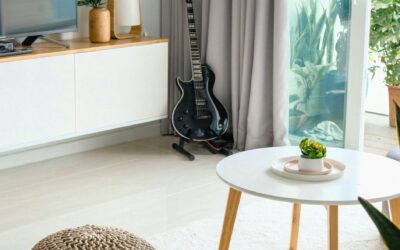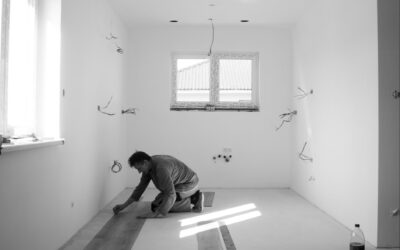LVT flooring is trending and it’s seeing a boost in popularity. Compared to solutions like laminate and real hardwood floors, luxury vinyl flooring has numerous advantages such as durability, comfort, waterproofing, and a superb range of colours and designs.
Did you know, however, that there are two types of LVT flooring relating to the base layer that sits beneath the aesthetic textured layer? These are rigid core LVT flooring and flexible LVT flooring. If you were unaware, I take a look at the rigid core vs flexible LVT case below so you can make the right choice for your new floor.
Before we delve into the different types, let’s take a brief look at the underlying LVT flooring category. This is a tiled flooring solution whose main material component is vinyl. There are two main installation types – glue-down (where the adhesive is used), and click LVT (where the tiles simply click together to form a floating floor). This type of flooring is also meant to serve as a cheaper alternative to hard floors like stone, hardwood, and ceramic tiles.
What is Rigid Core LVT?
Rigid core LVT is a type of floor tile made up of several layers and the primary material is vinyl. The typical composition of a rigid core tile is a transparent protective top layer, several protective wear layers, the patterned aesthetic layer, the rigid core layer, and a backing or underlayment layer.
It is the additional rigid core layer that sets this type of LVT flooring apart whereas flexible LVT just has a standard base layer. The types of rigid cores include SPC (stone plastic composite), WPC (wood plastic composite), and PVC (polyvinyl chloride).
Pros
- Rigid core LVT is thicker and more durable due to the enhanced core underneath the aesthetic layer.
- It is waterproof unlike laminate flooring and thus great for areas like kitchens.
- Due to the click-lock system where the tiles interlock, rigid core LVT is easy and quick to install.
- These floor tiles are available in a huge range of colours and patterns and can emulate different materials like stone, wood, marble, and ceramic.
- It is incredibly easy to maintain via hoovering and for cleaning stains.
Cons
- Compared to carpet, rigid core LVT flooring can feel colder and harder to walk on.
What is Flexible LVT?
Flexible LVT flooring is essentially any other type of LVT that doesn’t have a rigid core. This type of flooring has exactly the same layered composition including the top protective and wear layers and the aesthetic layer. However, it doesn’t have a rigid core but has a standard, flexible base layer. In terms of pros and cons, flexible LVT actually shares many of the same as rigid core LVT:
Pros
- Like rigid core LVT, flexible LVT flooring is waterproof which makes it easier to clean spills but also makes it ideal for use in bathrooms and kitchens.
- It has excellent longevity and due to the easy maintenance, this flooring can last for up to 20 years without needing placing.
- The range of colours and styles is excellent and you can get various shades such as beige, light grey, dark grey, black, brown, coffee, golden, and light browns.
- Quick installation regardless of whether it’s glue-down LVT or click VLT flooring.
Cons
- It doesn’t offer the same soundproofing or comfort as something like a carpet.
- Rooms with flexible LVT flooring can feel colder than rooms with a carpet.
Which is The Better Choice – Rigid Core vs Flexible LVT
I want to start out by saying that BOTH options are viable and there is no clear winner in the rigid core vs flexible LVT battle. However, there are some instances where rigid core is the better choice, and some people may simply prefer it.
For example, rigid core LVT flooring is better in frequently trodden rooms. If you have a room in your house that the entire family uses multiple times per day, the durability that the rigid core provides is beneficial.
Additionally, rigid core LVT flooring can feel better to walk on as there is more material between the subfloor and your feet. Therefore, if you want additional comfort then rigid core LVT can be more forgiving on your tootsies.
Both Flexible LVT and Rigid Core LVT Have Their Purpose
As you can see, you can’t simply discount one type of LVT flooring and it’s more a case of assessing your needs and considering where the flooring will be installed.
For high-traffic areas where people frequently walk such as hallways and kitchens, rigid core LVT flooring is the better option. The rigid core adds extra durability and it also feels slightly better to walk on.
However, for low-traffic areas such as bedrooms and bathrooms that are only used occasionally, flexible LVT flooring is perfectly adequate. Remember that both types of flooring look fantastic, are waterproof, incredibly easy to install and maintain, and can last for decades.









